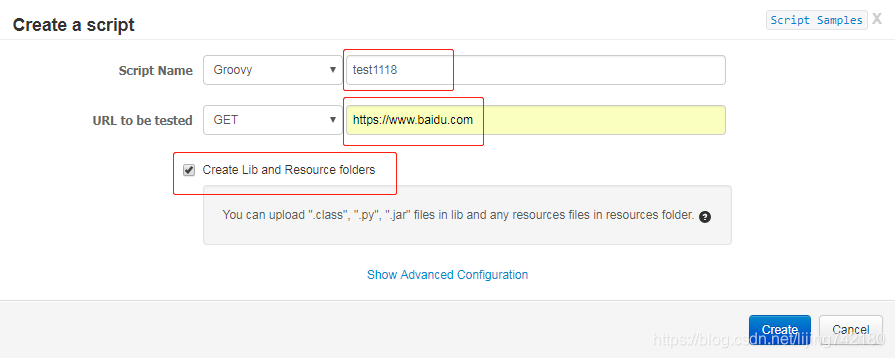版权声明:原创不易,欢迎分享和转载,同时请注明出处,谢谢! https://blog.csdn.net/lijing742180/article/details/84201570
原创不易,欢迎分享和转载,同时请一定注明出处:https://blog.csdn.net/lijing742180/article/details/84201570
个人公众号–【媛测】
上一篇文章中讲了ngrinder怎么快速发送一个GET请求,在此详细解读一下其中的脚本。
(前提是你已经了解了groovy的基本代码结构,如果还不了解的先看这里–搭建 nGrinder 性能测试平台 并快速使用)
一、自动生成GET请求脚本
1、配置 Create a script
在ngrinder管理台主页,点击script–>Create a script,并填写脚本名称和请求的url,如下所示:

点击 Create 按钮,nGrinder会自动生成对应的脚本结构,如果没有参数需要设置的话,可以直接运行了。
二、详细解析GET请求脚本
ngrinder自动生成的脚本如下所示:
解析见代码中的注释
import static net.grinder.script.Grinder.grinder
import static org.junit.Assert.*
import static org.hamcrest.Matchers.*
import net.grinder.plugin.http.HTTPRequest
import net.grinder.plugin.http.HTTPPluginControl
import net.grinder.script.GTest
import net.grinder.script.Grinder
import net.grinder.scriptengine.groovy.junit.GrinderRunner
import net.grinder.scriptengine.groovy.junit.annotation.BeforeProcess
import net.grinder.scriptengine.groovy.junit.annotation.BeforeThread
// import static net.grinder.util.GrinderUtils.* // You can use this if you're using nGrinder after 3.2.3
import org.junit.Before
import org.junit.BeforeClass
import org.junit.Test
import org.junit.runner.RunWith
import org.junit.FixMethodOrder
import org.junit.runners.MethodSorters
import java.util.Date
import java.util.List
import java.util.ArrayList
import HTTPClient.Cookie
import HTTPClient.CookieModule
import HTTPClient.HTTPResponse
import HTTPClient.NVPair
/**
* A simple example using the HTTP plugin that shows the retrieval of a
* single page via HTTP.
*
* This script is automatically generated by ngrinder.
*
* @author admin
*/
@RunWith(GrinderRunner)
@FixMethodOrder(MethodSorters.NAME_ASCENDING)
class TestRunner {
public static GTest test
// 定义 HTTPRequest 静态变量 request,用于发送 HTTP 请求
public static HTTPRequest request
// 定义 NVPair 数组 headers ,用于存放通用的请求头数据
public static NVPair[] headers = []
// 定义 NVPair 数组 params ,用于存放请求参数数据
public static NVPair[] params = []
// 定义 Cookie 数组 cookies ,用于存放通用的 cookie 数据
public static Cookie[] cookies = []
@BeforeProcess
public static void beforeProcess() {
// 设置请求响应超时时间(ms),超过则抛出异常
HTTPPluginControl.getConnectionDefaults().timeout = 6000
// 创建GTest对象,第一个参数1代表有多个请求/事务时的执行顺序ID
// 第二个参数是请求/事务的名称,会显示在summary结果中
// 有多个请求/事务时,要创建多个GTest对象
test = new GTest(1, "www.baidu.com")
// 创建 HTTPRequest 对象,用于发起 HTTP 请求
request = new HTTPRequest()
grinder.logger.info("before process.");
}
@BeforeThread
public void beforeThread() {
// 注册事件,启动test,第二个参数要与@Test注解的方法名保持一致
// 有多个请求/事务时,要注册多个事件
test.record(this, "test")
// 配置延迟报告统计结果
grinder.statistics.delayReports=true;
grinder.logger.info("before thread.");
}
@Before
public void before() {
// 在这里可以添加headers属性和cookies
request.setHeaders(headers)
// 设置本次请求的 cookies
cookies.each { CookieModule.addCookie(it, HTTPPluginControl.getThreadHTTPClientContext()) }
grinder.logger.info("before thread. init headers and cookies");
}
@Test
public void test(){
// 发送GET请求
HTTPResponse result = request.GET("https://www.baidu.com", params)
// 断言HTTP请求状态码
assertThat(result.statusCode, is(200))
}
}
GTest
- GTest是对测试记录进行统计的单元;
- 使用 GTest 的构造方法 GTest(int number, String description) 创建,在脚本内每个GTest对象都使用唯一的编号定义。
- 如果创建了多个编号一样的对象,最后只会选用第一个。
test.record()
在@BeforeThread注解下会执行 test.record(this, "test")
- record(Object target, String methodName)
- 这里使用 GTest的record方法给 GTest 配置需要进行统计的方法;
- target 指脚本对象,这里是this;
- methodName 是需要统计的方法名,通常都是被 @Test 注释的方法。如果未配置,方法会正常执行,但是没有统计结果数据;
- 每一个被 @Test 注释的方法都是一个整体事务,在运行测试时,即便里面有 多次 HTTP 请求也只做一次统计!!
Cookies
可以通过 Cookie(String name, String value, String domain, String path, Date expires, boolean secure) 构造 cookie 对象,然后存放到相应的数组中,传递到请求中。